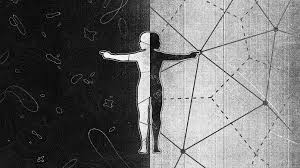 wired.com
wired.com
The whole world in your little TOE |
| Even
in the highest spheres of natural science, humankind exists. When
people began to dream of subjecting the entire spectrum of the
observable world, from the smallest to the largest, to a universally
valid formalism, the term 'Theory of Everything' was coined, along with
the diminutive acronym TOE. To this day, this quest has remained
unsuccessful. |
| One
approach, 'string theory,' postulates six additional dimensions beyond
four-dimensional space-time. This proposal has so far remained purely
abstract. No one can imagine what such additional dimensions mean, let
alone conduct concrete experiments to prove their existence. |
| One would only have to consider what all must 'be the case' for us (to quote Wittgenstein's
'Die Welt ist alles was der Fall ist'), to be convinced of a real state
of affairs. Location in space and point in time, the 4 basic
dimensions, are not enough on their own. Since Heisenberg
at the latest, we have known that no facts can be secured without
taking into account the observer. Each observation leaves its mark on
the observed. |
| As if that weren't enough, a single observer is in a weak position. Since Immanuel Kant
at least, we've known that no observation is absolutely reliable. Every
observation requires independent confirmation. In a metaphorical sense,
one could imagine observation as a one-dimensional event, and its
confirmation as the addition of another dimension. |
| Now
all that's missing is a scientific collective that can bring all the
individual observations together and craft something of general
validity from them. Without air resistance, the speed of a falling body
increases with the square of the distance traveled. All the consistent
individual observations are extrapolated into a space of possibilities
with the prediction: Whoever, wherever and whenever, investigates this
specific relationship (falling speed and distance traveled) will find
the same formalism confirmed. |
| Perhaps
these are three of the additional dimensions proposed by string theory.
But would that do justice to 'true' reality? Even the most intelligent
collective remains fallible. We've known this since Sir Karl Popper
at the latest. All 'knowledge,' however certain it may seem to us
today, is provisional and not immune to being overturned or at least
refined in the distant or near future. |
| One
may be led to suspect that the ten dimensions suggested by string
theory are not as ambitious as they seem at first glance. If one wants
a 'Theory of Everything,' one must also expect to reach the limits of
human imagination. |
| Where
are these limits? The last 100 years or so have taught us that exact
science has its limits. The best thing you can say about serious
science is that it recognizes the limits of its validity (think of Kurt Gödel's incompleteness theorem). Beyond these limits, chance takes over. |
| Quantum
theory gives this chance its due. However, it also presents us with
some oddities that don't quite fit into our traditional worldview. The
indeterminacy of chance contrasts with the property of particle pairs,
which maintain their relationship to one another with astonishing
perseverance over great distances and periods of time ('entanglement'). |
| Isn't
it touching how science continually finds expressions for the seemingly
inexpressible? Such a paired particle may follow its lonely path until
- discomforted by an unintentional encounter - it is forced, for the
first time in its more or less long 'life,' to reveal itself as the
bearer of a specific property, of which there are only two possible.
(If it had the honor of participating in an experiment, the encounter
was, of course, not unintentional.) |
| What
sounds like an exotic phenomenon brought about by resourceful
researchers could well be commonplace in the universe. We know of
natural processes that constantly generate such pairs. One example is
the positron-electron collision, which results in a diverging photon
pair (Ivashkin et al. 2023). The typical 511 keV signature is found
particularly in the galactic center (Prantzos et al. 2010). |
| It's
hard to imagine that after positron-electron collisions in stars, both
generated photons would continue their trajectories undisturbed for
long. More likely, one would disappear into space and the other into
the star's interior. However, positrons are also present in cosmic
radiation (Adriani et al. 2009). If such a positron collides with an
electron in empty space (e.g., a grain of dust), the two photons could
drift apart undisturbed for a long time. Space could be teeming with
entangled particles, but no algorithm is conceivable that would allow
the identification of the respective partners. |
| But
just because we can't find them doesn't mean they're meaningless.
There's more between heaven and earth than we can imagine. Fortunately,
the string model still leaves us with three more dimensions... |
| Adriani
O, Berbarino GC, Bazilevskaya GA, Bellotti R, Boezio M et al (2009) An
anomalous positron abundance in cosmic rays with energies 1.5-100 GeV.
Nature 458, 607-09 Ivashkin A, Abdurashitov D, Baranov A et al (2023) Testing entanglement of annihilation photons. Sci Rep 13:7559 Prantzos N, Boehm C, Bykov AM, Diehl R, Ferričre K, Guessoum N et al (2010) The 511 keV emission from positron annihilation in the galaxy. Rev Modern Physics 83.1001 |
| MB (12/24) |
| The
idea of taking social phenomena into account in the search for a
comprehensive, formalized description of reality has occupied me since 1989 (in German only). |
| next: On the likelihood of rare events back to At the border between fiction and reality see also Cosmology & Space Flight |